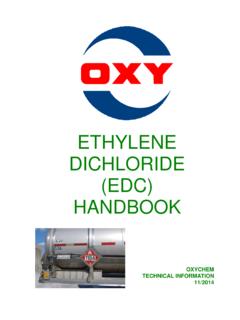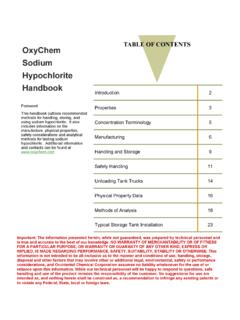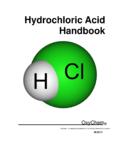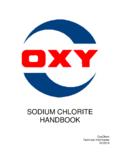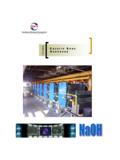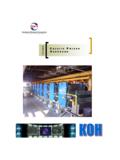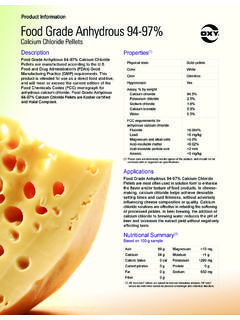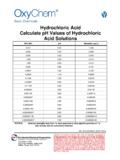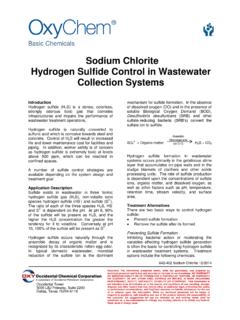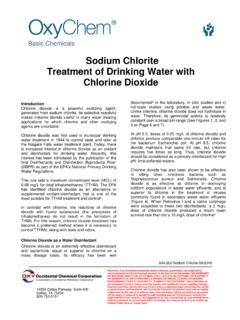Transcription of ETHYLENE DICHLORIDE (EDC) HANDBOOK
1 ETHYLENE DICHLORIDE (EDC) HANDBOOK OXYCHEM TECHNICAL INFORMATION 11/2014 1 Dallas-based Occidental Chemical Corporation is a leading North American manufacturer of basic chemicals, vinyls and performance chemicals directly and through various affiliates (collectively, OxyChem). OxyChem is also North America's largest producer of sodium chlorite. As a Responsible Care company, OxyChem's global commitment to safety and the environment goes well beyond compliance. OxyChem's Health, Environment and Safety philosophy is a positive motivational force for our employees, and helps create a strong culture for protecting human health and the environment.
2 Our risk management programs and methods have been, and continue to be, recognized as some of the industry's best. OxyChem offers an effective combination of industry expertise, experience, on line business tools, quality products and exceptional customer service. As a member of the Occidental Petroleum Corporation family, OxyChem represents a rich history of experience, top-notch business acumen, and sound, ethical business practices. 2 Table of Contents Page Introduction to ETHYLENE DICHLORIDE .. 3 Manufacturing .. 3 ETHYLENE DICHLORIDE (EDC) Uses .. 4 Specifications and Product Grades.
3 4 Safety and First Aid .. 4 Hazards .. 4 Respiratory Protection .. 5 Safety Precautions .. 6 First Aid .. 7 Toxicity .. 8 Regulatory .. 8 US Environmental Protection Agency .. 8 US Food and Drug Administration .. 9 World Health Organization .. 9 Handling and Storage .. 9 Shipping .. 9 Barge .. 9 Tank Trailers .. 10 Tank Cars .. 10 Storage & Equipment .. 11 Maintenance of Storage Facilities .. 14 Spills and Precautions .. 15 Technical Data .. 16 Product Sampling .. 16 Physical Properties .. 16 Graphs .. 17 Density v. Temperature .. 17 Vapor Pressure v. Temperature .. 18 Solubility of Water in EDC v. Temperature.
4 19 3 MANUFACTURING The chemical compound 1,2-dichloroethane, commonly known as ETHYLENE DICHLORIDE (EDC), is a chlorinated hydrocarbon, mainly used to produce vinyl chloride monomer (VCM, chloroethene), the major precursor for PVC production. It is a colorless liquid with a chloroform-like odor. ETHYLENE DICHLORIDE is also used generally as an intermediate for other organic chemical compounds, and as a solvent. ETHYLENE DICHLORIDE is produced through the iron(III) chloride catalyzed reaction of ethene ( ETHYLENE ) and chlorine. H2C=CH2 + Cl2 Cl-CH2-CH2-Cl In subsequent reactions, notably to vinyl chloride (chloroethene), hydrogen chloride is formed and re-used in a copper(II) chloride catalyzed reaction, to also produce 1,2-dichloroethane from ethene and oxygen.
5 H2C=CH2 + 2 HCl + O2 Cl-CH2-CH2-Cl + H2O OxyChem uses both reactions to manufacture EDC, the first is a direct chlorination reaction (see Figure 1) and the second is an oxychlorination reaction (see Figure 2). Many licenses for variations of each type of process exist today. Figure 1 and 2 are general process descriptions for each type of reaction. Figure 1: Direct Chlorination Reaction 4 Figure 2: Oxychlorination Reaction ETHYLENE DICHLORIDE USES EDC is used primarily as a raw material in the manufacture of vinyl chloride monomer (VCM). The vinyl chloride, in turn is used to manufacture polyvinyl chloride (PVC) resin.
6 EDC is also used as an intermediate in the manufacture of chlorinated and fluorinated compounds. EDC has been used as a solvent in the textile, metal cleaning and adhesive industries. SPECIFICATIONS AND PRODUCT GRADES OxyChem produces and markets Technical Grade ETHYLENE DICHLORIDE at the Geismar, LA facility with a minimum purity of by weight. Material produced and shipped from OxyChem s Geismar, LA plant conforms to the chemical testing requirements of several industrial standards such as the General Use EDC for the ACS Specifications for Reagent Chemicals, 10th Edition; the Food Chemicals Codex, 8th Edition.
7 The manufacturing process for EDC does not incorporate all of the measures specified in the Food and Drug Administration s current Good Manufacturing Practices (cGMP). It is the responsibility of the user to assess their use of EDC products in food, feed, or pharmaceutical related applications and to determine whether appropriate regulatory requirements are being met. OxyChem Technical Grade EDC meets the Military Specification MIL-D-10662-D which was replaced by ASTM D5960-03. OxyChem also manufactures EDC at its Convent, LA plant. Product manufactured at Convent, LA is marketed as Finished Grade ETHYLENE DICHLORIDE with a purity of greater than by weight.
8 OxyChem's Technical Services Department can provide more product information. Call or write the Technical Services Department OxyChem Box 12283, Wichita, KS 67277-2283 800-733-1165, SAFETY AND FIRST AID Hazards EDC is a flammable, toxic chemical and should be handled with extreme care. Personnel should be properly trained in the handling of EDC and should always wear the proper protective equipment when working with, and around EDC. All users 5 Figure 3: Personal Protective Equipment should read the proper Material Safety Data Sheet (MSDS) before handling EDC.
9 The primary health hazard associated with the use of EDC is overexposure due to the inhalation of vapors above the OSHA PEL. The Occupational Safety and Health Association (OSHA) has established Permissible Exposure Limits (PEL) of 50 ppm. The PEL is the allowable average concentration to which workers may be exposed, 8 hours per day, five days a week, without adverse effects. OSHA has also established a Short Term Exposure Limit (STEL) of 100 ppm ceiling for EDC, which is a 15 minute average exposure that should not be exceeded. Also OSHA has established a Peak (5 minutes in any 3 hour period) of 200 ppm.
10 Likewise, the American Conference of Governmental Industrial Hygienists (ACGIH) has established Threshold Limit Values (TLV) of 10 ppm for this product. Work areas employing EDC should be isolated and contained. A local exhaust should provide adequate ventilation to limit solvent vapors to below exposure limits. It is recommended that employees be provided with and required to use chemical impervious clothing, gloves, boots, splash proof goggles and other appropriate protective clothing necessary to prevent any possibility of skin contact with EDC.
